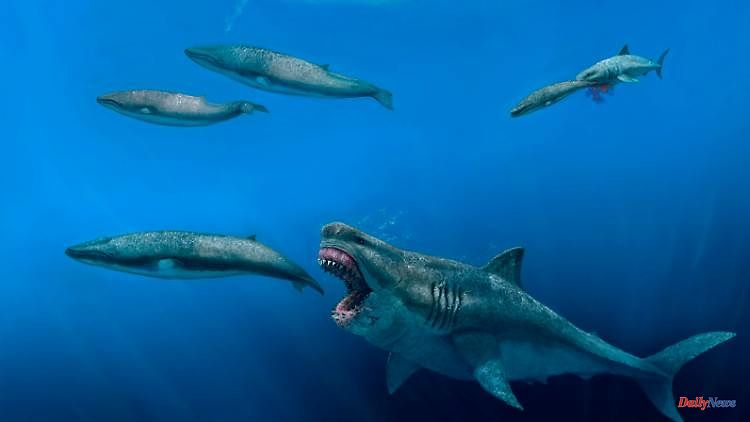Otodus megalodon has been extinct for 3.6 million years. The prehistoric predator was the largest shark in the history of the earth. However, its appearance could only be guessed at - so far.
New research has enabled the first 3D model of what is likely the largest shark in Earth's history: a megalodon, Otodus megalodon. This is reported by a team of researchers led by paleobiologist Jack Cooper from Swansea University in the UK in the journal Science Advances. The work was based on exceptionally well-preserved megalodon fossils from the Royal Belgian Institute of Natural Sciences. Megalodon teeth and scans of existing great white sharks were also included in the calculations.
It was difficult for the scientists to get a clear picture of the megalodon, study author Catalina Pimiento is quoted as saying in the British "Guardian". According to the paleobiologist, the skeletons of the legendary predators were made mostly of soft cartilage that doesn't fossilize well. Only the denser parts of the cartilaginous skeleton - especially its vertebrae - can be preserved under the right conditions. So the scientists used the few fossils available, including the rare collection of parts of a megalodon spine in Brussels.
Measurements and scans of each individual vertebra formed the basis for a reconstruction of the entire megalodon spine. The dentition was added from a scan of Megalodon teeth in the USA. A 3D scan of a South African great white shark was then used to fill in the body around the reconstructed spine and jaw.
According to this, the megalodon, whose spine formed the basis of research, was around 16 meters long from nose to tail. That's about two to three times the size of today's great white shark. The head alone accounts for 4.7 meters and the tail for 4 meters. The dorsal fin was therefore about 1.6 meters high. Presumably, animals could even grow up to 20 meters long.
Based on their digital creation, the researchers calculated that the megalodon would have weighed about 70 tons. That would be about as much as ten elephants. "Weight is one of the most important characteristics of an animal," says evolutionary biomechanist John Hutchinson of the UK's Royal Veterinary College. "For extinct animals, we can estimate body mass using modern 3D digital modeling methods and then establish the relationship between mass and other biological properties such as speed and energy expenditure."
Otodus megalodon is thought to have evolved around 23 million years ago and died out around 3.6 million years ago for reasons that are still unknown. Remains have been found on every continent except Antarctica. This suggests that megalodons ruled the ocean worldwide. The model also allows assumptions about the way of life of the giant. According to the model, the Belgian megalodon could have opened its mouth 1.8 meters wide and had a stomach volume of around 9.6 cubic meters. From these readings, the team concluded that the animal could completely eat a prey animal about eight meters long - the size of an adult orca - in just five bites.
The calorie count of such a meal would be enough to feed Megalodon for two months while it swam through Earth's oceans. This is similar to great white sharks, which can go a month or two without food if given a large enough meal. The team found that Megalodon's travel speed was more than five kilometers per hour. Great white sharks can swim about three kilometers per hour.
The disappearance of megalodon from Earth's oceans may have fundamentally changed underwater ecology, the team concludes. "Taken together, our results suggest that O. megalodon has played an important ecological role as a transoceanic superpredator," the scientists write. Its extinction likely affected global nutrient transport.












